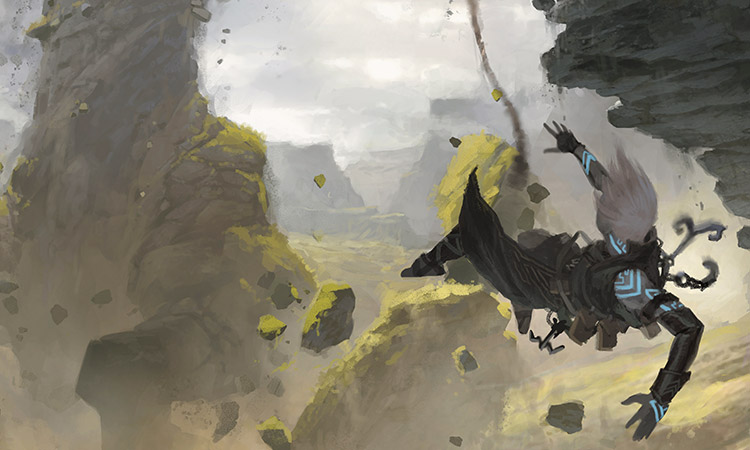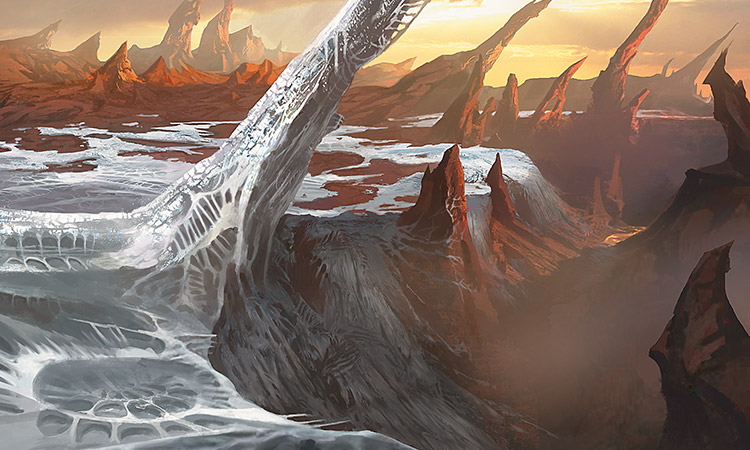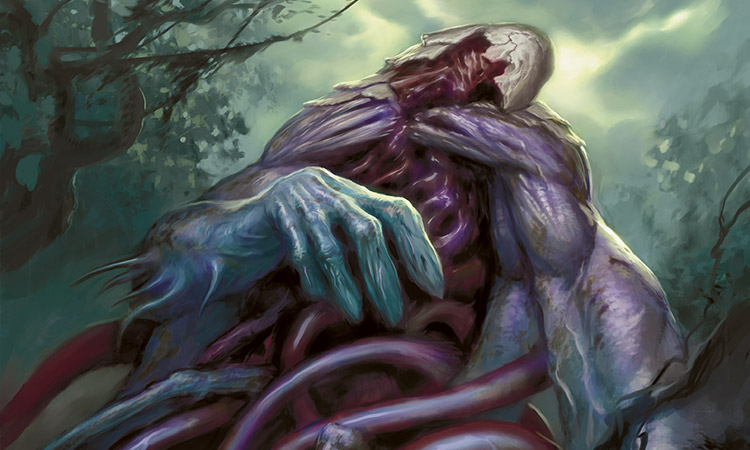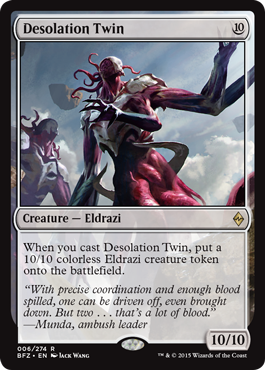Preparing for Battle, Part 1
Welcome to the first Battle for Zendikar preview week. It's time to start talking about our next big set! Battle for Zendikar's design has a very interesting story and, as this is the design column, I should probably tell it. I even have a cool preview card, which I designed myself. Sound good? Then let's get started.
To understand where Battle for Zendikar design had to start, we must first go back to the original Zendikar block. Zendikar design came out of a feeling I had that there was a lot of potential for land mechanics. That idea wasn't particularly well received at the time (the response was almost always "What else do you have?"), but I had built up a lot of trust over the years, so R&D gave me some time to try and demonstrate my vision.
The Zendikar design team spent over a month designing land mechanics, and when the dust settled we'd created landfall as well as a number of other land-related cards and cycles, and realized that we wanted to bring back kicker to make use of all the mana you were going to have. This mix of mechanics led the creative team to come up with the idea of making Zendikar an adventure world. From that, we went back and designed allies, traps, and quests to mechanically capture the adventure-world feel.
While R&D liked what my design team had created, they were skeptical it would work for three sets, so the idea was the third set (which was a large set) would be mechanically unconnected and would occur in its own world. The creative team, not having the resources at the time to make a second world, came up with a radical story element that would justify the complete mechanical change over while allowing us to stay on Zendikar.
That idea was that there was something trapped inside the plane, which was causing the wild reactions of the land. Giant ancient colorless titans had been imprisoned within Zendikar, and through a series of events—masterminded by Nicol Bolas—the Eldrazi were set free. The third set was called Rise of the Eldrazi and was all about the world reacting to the presence of these strange and dangerous creatures. After thousands of years of imprisonment, the unfathomable Eldrazi were free and . . . scene!
Yes, the Zendikar block ended on a cliffhanger. The Eldrazi were free. What did this mean for Zendikar and the Zendikari (the name for the inhabitants of Zendikar)? What did this mean for the Multiverse? Did the three titans stay? Did they go? Find out . . . sometime in the future. This is important, because when I was assigned the design for Battle for Zendikar, I knew, first and foremost, we had to resolve the cliffhanger.

Sheer Drop | Art by Clint Cearly
When Worlds Collide
When I sat down to examine the resolution of the cliffhanger, I realized there were four possible outcomes:
- Outcome #1: The Eldrazi beat up Zendikar a bit and then left.
- Outcome #2: The Eldrazi (or some portion of them) stayed, and the Zendikari managed to fend them off and felt like they had won—but had they? (Dun dun dun!)
- Outcome #3: The Eldrazi (or some portion of them) stayed, and there is now an ongoing war between the Eldrazi and the Zendikari where neither side seems to have the advantage.
- Outcome #4: The Eldrazi (or some portion of them) stayed and dominated. The Zendikari are on the verge of losing everything.
Let's go through them one by one.
Outcome #1: The Eldrazi beat up Zendikar a bit and then left.
This one felt emotionally unsatisfying. We come back and the threat has disappeared. Yes, we could easily make a fun new set based on Zendikar, but not having the Eldrazi even be there felt like we were failing to live up to our promise of a resolution.
Outcome #2: The Eldrazi (or some portion of them) stayed, and the Zendikari managed to fend them off and felt like they had won—but had they?
My feeling on this outcome is "been here, done that." The unsuspecting world slowly being taken over was exactly what happened on Mirrodin. We could try to have a few new twists, but the concern was the story beats and mechanical execution would simply be too familiar.
Outcome #3: The Eldrazi (or some portion of them) stayed, and there is now an ongoing war between the Eldrazi and the Zendikari where neither side seems to have the advantage.
Magic does conflict all the time. This could work structurally, but we were worried that this would undercut the threat of the Eldrazi. If the Zendikari could fight them to a standstill, just how much of a threat are the Eldrazi?
Outcome #4: The Eldrazi (or some portion of them) stayed and dominated. The Zendikari are on the verge of losing everything.

Art by Jung Park
This final outcome I called the "rebel option." This played into the archetype where the bad guys, often outside invaders, have won the conflict and the good guys are reduced to a small band of rebels fighting desperately to save their home.
Each outcome leads to a different design, so I talked with the creative team about which outcome they preferred from a story standpoint. I clearly preferred the fourth option, but I felt any option (probably other than the first one) was doable. They agreed that returning to Zendikar with the Eldrazi triumphant made the most sense.
Return of the Eldrazi
With the larger structure in place, the next question to answer was what should be returning? Whenever you do a block where you go back to a world you've visited before, it's important to strike a balance between having enough repeated mechanical elements so that it feels like you've made a return, but with enough new stuff that the set doesn't feel like just a rehash of what you did last time.
Now remember, while we were going back to the plane of Zendikar, mechanically we were returning to two different pseudo-blocks. Zendikar and Worldwake were all about land mechanics, an adventure world, and the plane's inhabitants. Rise of the Eldrazi was all about the Eldrazi and the resistance that forms to stop them. We had to make sure that we had mechanical elements from both "blocks" as well as from each side.
Let's take a look at what mechanics we had:
(Note that I list "full-art basic lands"; when we did market research on the set, "full-art basic lands" was the favorite "mechanic" in the set. They're not actually a mechanic, but are definitely a component players might expect.)
Zendikar
- Full-art basic lands
- Landfall
- Kicker
- Allies
- Quests
- Traps
Worldwake
- Multi-kicker
Rise of the Eldrazi
- Annihilator
- Level up
- Rebound
- Totem armor
- Colorless spells
- Eldrazi Spawn
The first thing we did was to divide the list into two parts: things we could and would bring back, and things we couldn't or wouldn't bring back.
Things We Could Do:
- Full-art basic lands
- Landfall
- Kicker
- Allies
- Quests
- Traps
- Multi-kicker
- Totem armor
- Colorless spells
- Eldrazi Spawn
Things We Couldn't Do:
- Annihilator
- Level up
- Rebound
Let's walk through the Couldn't Do list first. Annihilator proved to be a very disliked mechanic in our market research. Playing against it ended up being something that almost always made you lose, but it did so slowly and painfully without giving you much opportunity to make a comeback. It also made the cards play the same, and developmentally it was hard to use on anything but expensive creatures.
Level up was a very mixed bag in market research. The frames were kind of clunky and led to some confusion. Also, they were very complex and one of the reasons that Rise of the Eldrazi is the only modern expansion since the introduction of New World Order to not actually follow New World Order (more on this in a bit). We were already going to have complexity issues to grapple with trying to cram two different "blocks" into a single block. We didn't have the luxury of using such a complex mechanic.
Rebound was just used in Dragons of Tarkir. I should note that the Dragons design team did come and talk with me about rebound and I was okay with giving it up, because it had very little to do flavorfully with either the Eldrazi or the Zendikari.
As it was important that the returning mechanics had a lot of flavor, the next thing we did was divide the remaining list into two camps: flavorful of either the Eldrazi or the Zendikari, or not flavorful.
Flavorful:
- Full-art basic lands
- Landfall
- Allies
- Quests
- Traps
- Colorless spells
- Eldrazi Spawn
Not Flavorful:
- Kicker
- Multi-kicker
- Totem armor
Let's walk through the unflavorful list. Kicker and multi-kicker mechanically made sense in the original Zendikar block, because the "land matters" element of the block ended up with the players having lots of mana to spend. Nothing about either form of kicker was inherently flavorful, just functional. Totem armor was a solid mechanic that played well, but it didn't do a great job of capturing the flavor of the Zendikari. It also relied on having numerous Auras, which we didn't necessarily want to have to support.
We then took the remaining list and broke it into two parts: Eldrazi and Zendikari.
Eldrazi:
- Colorless spells
- Eldrazi Spawn
Zendikari:
- Full-art basic lands
- Landfall
- Allies
- Quests
- Traps
When the dust settled, it turned out we didn't really have all that much Eldrazi stuff that we could easily return. We had colorlessness—especially on spells (as normally there's no way to make colorless spells; artifacts can make colorless permanents)—and we had Eldrazi Spawn. Eldrazi were obviously going to have some big creatures (as that was another of their memorable traits), which meant we needed to have a means to help make sure you could cast them. Colorless spells and Eldrazi Spawn were in.
Zendikar has always been the world all about land, so the expectation for full-art basic lands to return would be high. That would be an easy thing to bring back. It has no real impact on the design or mechanics, but we signed off on it early (after checking in with the art team). Next we have landfall. No mechanic is more iconic to Zendikar than landfall, so it was definitely something we wanted to bring back.
Next we had Allies. Obviously, we would be bringing back the creature type. The big question was would they have the same mechanic (note that the Ally mechanic was never named in Zendikar) or a different one? Design thought that there was space to try something a little different while still keeping the feel close. The idea was if you mixed together Zendikar Allies and Battle for Zendikar Allies in the same deck, they should play well with one another.
We talked a lot about Quests and Traps. We had put them in the original block to help convey the adventure-world theme. The problem was, we were trying to tell the story about the Eldrazi and the Zendikari, and that meant we had less space for background design. We decided that we'd keep an open mind, and if a good spot for either Quests or Traps came up, we'd consider adding it. But to start off, we weren't going to assume either was in the set.
After all that, here's what we ended up with:
- Colorless spells
- Eldrazi Spawn
- Full-art basic lands
- Landfall
- Allies (with most likely a new but similarly flavored mechanic)
Fathoming the Unfathomable
To understand the problem of mechanically defining the Eldrazi, we need to go back to Rise of the Eldrazi. Brian Tinsman was the lead designer, and he was determined to bring the Eldrazi to life. Brian had long been a fan of the Cthulhu mythos, and was willing to do whatever the design needed to match the ancient, giant, alien, world-eating beings. How could Brian convey they were ancient? He came up with the idea of making them colorless to show that they predated colored magic. How could he convey their enormous size? Just make them huge. But how would anyone ever get to play them if they were so expensive? That's when Brian came up with the idea of "battlecruiser Magic," where the entire environment was slowed down to give the giant Eldrazi a chance to get played.
Brian also came up with other solutions to help enable playing them. Originally he had a mechanic that gave a counter to the player that could be turned in at any time for one colorless mana. That counter ended up feeling too close to poison, a mechanic scheduled to return in the very next block, so Brian solved the overlap by turning his counters into 0/1 creatures. These Eldrazi Spawn ended up playing very interestingly, more so than the counters. To capture their voraciousness, he made the annihilator mechanic—where the Eldrazi "ate" huge swaths of your opponent's permanents.
When he was done, Brian had brought the Eldrazi to life, but at a cost. As I said above, New World Order was tossed out the window. Brian wasn't focused on Magic design, so this was the first set he'd worked on since we started New World Order and he just wasn't used to it. So when there were forks in the road that allowed him to realize his vision, he often took ones that led away from New World Order.
The end result was the creation a Limited environment that was unlike any other. If you could figure out what was going on, there was all sorts of offbeat gameplay. But if you didn't, the Limited gameplay was filled with traps that would result in your deck disastrously not working. Putting a simple thing like a 2/2 creature for two in your deck, which normally was functional, became a mistake. The end result of all this is that the audience diverged greatly on Rise of the Eldrazi. The enfranchised Limited players loved it. It was different and quirky and rewarded skill. The less enfranchised players hated it. They didn't understand what was going on and would always lose with game states that were painfully unfun.

Ulamog's Crusher | Art by Todd Lockwood
The challenge laid before me and my team was to capture much of what was fun about the Eldrazi, without a lot of the baggage that turned off a huge swath of players. And this was a real challenge. I didn't feel I could use Annihilator. I didn't feel I could use "battlecruisier Magic." (This isn't to say that players can't ramp out giant Eldrazi; it meant that there needed to be normal options also available.) I was even concerned with how many giant creatures I could have, and at what rarity.
One thing was clear, though. There was one trait of the Eldrazi that I knew I could deliver on—colorlessness. One of the most memorable things about the Eldrazi is that they were colorless and could cast colorless spells. Now, if you actually look back at Rise of the Eldrazi, not all the Eldrazi are colorless. They also showed up in black, red, and green, but people's memories tend to forget that and I felt like if I was going to give the Eldrazi a cohesive identity, I needed to make use of colorlessness throughout all the Eldrazi.
All colorless Eldrazi had a problem though, one I had learned the hard way during Mirrodin design. In order for the Eldrazi to be an imposing force, there had to be a volume of them—but too many colorless cards tends to undermine the color pie. Was there a way to have colorlessness without undercutting the color pie? It turns out there was.
One of the future-shifted cards from Future Sight was a card called Ghostfire. It was a direct-damage spell that cost red mana to cast but was colorless. It was made at the time as a means to get around white protection spells, which particularly protected white from red spells. Ghostfire might have been created with a completely different goal in mind, but it did solve the problem at hand. All the Eldrazi could be colorless if some of them required colored mana to cast.
During all of design, we just noted that the cards were colorless. I didn't believe, at the time, that we needed to keyword it, because I thought the actual frame would convey the colorlessness. In development, it became clear that we needed to make a special frame for these cards and that we had to have a keyword to make it clear what was going on. That's how these cards all became labeled with the mechanic devoid.
I liked how this would help us mechanically connect all the Eldrazi together. In addition, it allowed us another huge benefit. As all the Eldrazi were colorless, we could make "colorless matters" a thing. We don't use the Tribal card type any more, so there wasn't any other way to reference Eldrazi things that weren't creatures. Making everything colorless allowed us to tie everything together in a way we could mechanically care about. Also, the previous block had a major morph theme, so having "colorless matters" cards could tie elements of the two blocks together in Standard.
We had solved one piece, but the jigsaw puzzle was far from complete. Next week, I will continue explaining how we put together the Eldrazi mechanically, and then I'll explain how we did the same with the Zendikari.
But before I go, I still have a preview card to show you—an Eldrazi card, no less. Let me show you the card, and then I can tell you the story of its creation.

Interestingly, this card started as a green devoid sorcery that made two 10/10 colorless Eldrazi tokens. In development, they decided they wanted it to be a 10/10 Eldrazi that made a twin as a cast trigger, meaning a counterspell could only stop one 10/10 and not both.
I hope Desolation Twin gives you a little taste of what kind of threat the Eldrazi will be in the set.
Join me next week, when I'll continue the story of Battle for Zendikar design.
Until then, may you get to play a lot of colorless things.
"Drive to Work #258—Khans of Tarkir, Part 4"
This is part four of my seven-part series on the design of Khans of Tarkir.
"Drive to Work #259—Khans of Tarkir, Part 5"
This is part five of my seven-part series on the design of Khans of Tarkir.
- Episode 259 Khans of Tarkir, Part 5 (18.0 MB)
- Episode 258 Khans of Tarkir, Part 4 (16.0 MB)
- Episode 257 Keeping an Eye Out (14.9 MB)
- Episode 256 Khans of Tarkir, Part 3 (15.2 MB)
- Episode 255 Khans of Tarkir, Part 2 (15.3 MB)

